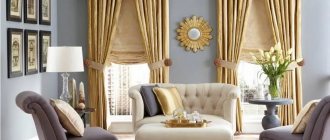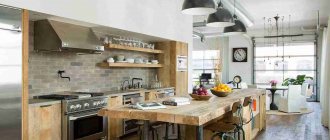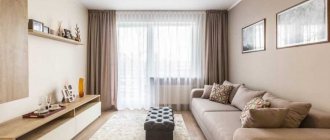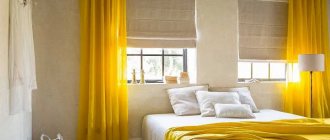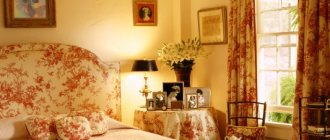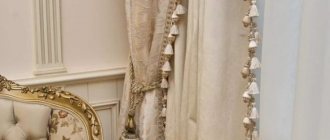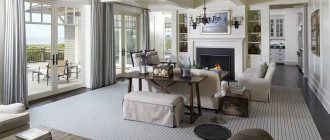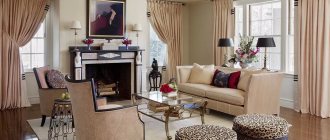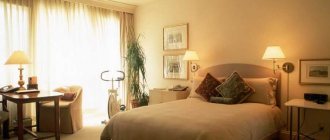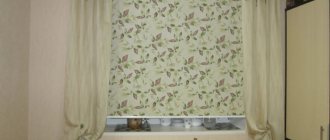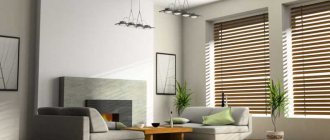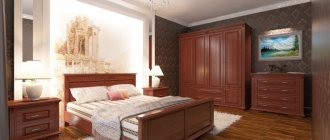Functions of lambrequins for the hall and living room
Having completed the renovation, many come to the conclusion that the old drapes or curtains are outdated and it’s time to change something. When choosing a style of curtains for a business room in a house, it is important to decide whether it will be a short curtain, a wide-format curtain or a lambrequin for a room without curtains. Beautiful tulle with side blinders and a carved addition in the center looks most elegant.
A rigid lambrequin is mounted on a ceiling baguette or a special strip, performing several functions:
- fills the space between the ceiling and the window opening;
- balances the proportions of the curtain composition;
- hides the fastening of multi-layer window decoration;
- determines the style in interior design;
- limits sunlight in the upper third of the window;
- harmonizes the aesthetics of the room.
Important! When choosing the style of lambrequins, it is important to have a sense of proportion so that the room does not look like Madame Pompadour’s boudoir or a provincial restaurant.
Multi-level curtains with a lambrequin in the living room should not be too pretentious. When they try to add palace chic to a modern interior, repeating the style of a bygone era, it will look tasteless.
The easiest way to track fashion trends in curtain design is through online catalogs and original proposals from design studios that produce window compositions. This is the best way to find out what fashionable curtains with a lambrequin for the hall should look like for 2022 - 2022.
Winning ideas
The following combinations are considered the most popular and universal:
- Matte tulle with a discreet pattern and a two-tone lambrequin with swags and jabot, combining a shade similar to the base and a contrasting tone.
- A short curtain with floor-length curtains and an elongated “top”.
- The combination of warm bright colors in the curtain composition.
- Combining simple transparent tulle with straight curtains, bamboo curtains and matching lambrequins.
Which fabric to choose for DIY sewing?
The interior textile market is represented by a variety of options from natural, synthetic and mixed fibers. Any curtain design studio gives preference to smooth, plain fabrics that look expensive.
Beautiful curtains with a lambrequin for the hall do not always have to be made of the same material. If the material of the curtains is heavy and rigid, then it is better to sew soft swags and interceptions from satin in the color of the curtains, decorating them with light drapery.
Cheap synthetics with metallized thread are no longer relevant. The most popular are double-sided jacquard fabrics, where a single-color pattern is formed from a special weave of threads. Such curtains have a matte pattern on a glossy background, but vice versa on the inside. Such fabric will not be able to form soft folds and scallops.
Rigid materials - for a wide strip with counter or bow folds. They hold well the ironed decorative elements of the part - a mold or “tie”, as in the example of a new lambrequin in a small room.
For a lambrequin with soft scallops of the “awning” type, soft silk fabrics are suitable. High-quality thin linen also drape well, but it has the disadvantage of being very wrinkled after washing. But there is a flax reaper that does not require ironing after the next wash.
Expensive panne velvet and iridescent plush are rarely seen in modern catalogs today. It was replaced with inexpensive but high-quality velor, which is also suitable for making beautiful lambrequins for the hall or living room yourself. But even a simple plain fabric will look good when complemented with luxurious accessories - fringe, tassels, silk ribbons and cords.
Classic methods of cutting a lambrequin
The type of drapery depends on the method of assembly, fastening and location of the fabric (along a lobar or along an oblique line). The combination of horizontal lambrequins in combination with vertical decorations looks beautiful.
There are also patterns for lambrequins with fixed names:
- “bell” (an oblong element with rolled edges);
- “mould” (complex symmetrical element);
- “tie” (with an oblique cut and creases in the front);
- “svagi” (arcs of different shapes);
- “de-jabot” (with corrugated folds).
If you want to sew window decor yourself, it is important to use the recommendations of the craftsmen on how to sew a lambrequin using a ready-made pattern.
Asymmetrical options
When choosing a curtain design, it is important to take into account the style of the interior and the practicality of the style. If beautiful decor prevents you from curtaining the curtain opposite the balcony door or wide transom, you will have to look for a way to solve the problem:
- abandon a multi-layer composition with a lushly draped lambrequin;
- choose an asymmetrical style;
- move the cornice with window decoration forward so that the doors do not come into contact with the fabrics.
- place a symmetrical version of the curtains on a special cornice that swings open towards itself.
For rooms with a balcony door, asymmetrical lambrequin patterns are suitable. Such models are quite functional and convenient, especially if you often have to go out onto a loggia or balcony.
A beveled bottom, asymmetry, decor with a soft interception on one side - all these methods are appropriate where you have to abandon symmetrical classic curtains.
In kitchen design
When decorating windows in the kitchen, you can use lambrequins of different types: both hard and soft. The first allows you to seamlessly decorate the top of the window, while hiding the cornice.
Rigid lambrequins come in a variety of shapes: oval, rectangular, square, etc. Such models are mounted under the ceiling, thereby covering the upper part of the tulle.
Soft lambrequins for kitchen windows have a special shape of fabric that gathers on the eaves in unusual folds. They also come in different varieties: puffs, ties and much more, it all depends on the size of your room and your flight of fancy.
Lighting plays a big role in the kitchen, so choose curtains and lambrequins made of a material that can easily let sunlight into the room.
If you are interested in the environmental friendliness of the material, then you should pay attention to natural fabrics - cotton, silk, bamboo, etc.
From a design point of view, calm tones are suitable for the kitchen. The combination of ethnic motifs and translucent fabrics looks beautiful. As you might guess, curtains in the kitchen will get dirty faster than in other rooms. Therefore, choose a material that is easy and pleasant to wash.
Combined lambrequins
With classic styles, we found out that it is important to decide on the style and suitable fabric. But what to do if you want to combine curtains and tulle with a lambrequin for a hall where different types of decor would be combined? Such models also exist.
Designers have long thought out all the asymmetrical and traditional variations, which combine a rigid template with holes into which panels of soft fabric are inserted.
Note! It is generally difficult to choose any model of lambrequins under the blinds so that such a duet is harmoniously perceived in the interior. If you want to hide the attachment of the entire structure to the cornice, it is better to replace it with a wide wooden baguette or a ceiling strip for baguette tape.
Complex, layered designs serve multiple functions, including balancing the proportions of a room. Complex models are often chosen to draw attention to the window decoration.
This is justified in cases where there is no stylistic connection to the interior, and window textiles dictate the overall mood. A selection of photos of lambrequins for the hall shows how to create something unusual with your own hands from ordinary fabric.
How to choose a lambrequin according to the type of room lighting?
Any fabric takes away some of the lighting. This must be taken into account when sewing curtains with lambrequins with different light levels:
- North-facing windows should let in maximum daylight. The more transparent the tulle and lambrequin, the better.
- A rigid gang made of dense material is suitable for a window opening on the south side of the house. It will protect your eyes from blinding light on a hot summer day. Curtain compositions in cool shades are a priority. Bright colorful fabrics are acceptable.
- The eastern windows greet the first rays of sunlight, but the illumination of the room quickly changes. We recommend combined curtains with a shortened lambrequin that lets in enough light. It is recommended to select materials in pastel colors.
- Western and southwestern windows receive a lot of sunlight, especially in the southern regions. In this case, a symmetrical cut of the lambrequin is appropriate, with a predominance of fabric folds to the south. Contrasting combinations are preferred.
In addition to the above, experts selected the most successful examples with photos of lamberquins in interiors of different styles. This will help you navigate when choosing the style that will most organically fit into your favorite interior of a bedroom, living room, children's room or kitchen.
Kinds
There are three types of lambrequins: hard, soft and combined.
The hard one is made of dense fabric, additionally treated with non-woven fabric, dublerin or stretched over a wooden frame. Sometimes it is made entirely of wood; in this case it is a decorative decoration of the cornice. A wooden lambrequin is an expensive thing and is not appropriate in all interiors.
The photo shows a rigid bandeau lambrequin in a soft lilac color with floral ornament trim.
A rigid lambrequin goes well with both classic curtains and tulle, as well as Roman or roller blinds. Due to its hardness, it can have completely different shapes. In classic interiors, simple rectangles or arches are more common. And you can cut out a wide variety of shapes from the base: tree branches, animals, birds.
A soft lambrequin is the most popular choice for a hall, as it gives the room an elegant and formal look. It is a flowing and harmonious ensemble, consisting of various elements with a wide variety of types of drapery.
Lush and modest draperies with teeth, ribbons and tassels are in fashion now. The simplest type is a strip of fabric gathered with braid. Complex ones can consist of several individual elements.
In the photo, the most popular option for the hall is a soft lambrequin.
The most common are:
- Jabot, or de jabot, is a lambrequin detail located on the sides. It got its name because of its resemblance to a detail of an ancient costume - a frill. The jabot is cut on the bias - this is how the fabric forms soft folds.
- The tie is the same de jabot, but located in the middle. This is an integral part of classic design.
- Swags are semicircular parts with soft round folds. They are universal and will fit perfectly into any interior, be it strict classics or modern minimalism. Swags are often cut from fabric of a contrasting color, and in classic interiors they are additionally decorated with tassels or fringe. Asymmetrical swags, in which one “wing” is longer and wider, are in fashion now. Thanks to this, the design of the curtains looks unusual, and various combinations give the window frame lightness and elegance.
- Chill molds are double folds laid behind each other.
- The bell, or bell, is a part with characteristic conical folds.
- Buffs are the upper part of a lambrequin assembled in a special way. Outwardly, they resemble wicker. Typically, puffs are made from fabric of a contrasting color, which enlivens the overall appearance of the window. Suitable for classic interiors with a claim to luxury.
The combined lambrequin is again on the list of trends for the season. It harmoniously combines elements of a soft and hard look, which allows designers to offer original window decor options.
Tips for choosing
Tulle is used to decorate windows in different stylistic directions - classic, minimalism, country, this material is in harmony with any room design. Window drapery and color choice directly depend on the size of the room, lighting and style of the living room.
If the windows face south or east, then during the day the room is sufficiently lit, so the fabric must be chosen either thick or dark. This will dim the too bright sunlight. But you need to remember that such a technique will be advantageous in a large room, but will visually reduce a small one.
To visually expand a small room, it is better to use light, transparent tulle. If the window is small, then you can hang a cornice that is longer than its width, this will make the room more spacious and the opening larger. Designers often use a technique that visually enlarges a room - they choose tulle with vertical stripes for windows.
It is sold ready-made or in rolls. When choosing a finished product, you need to take into account the height of the ceiling, the width of the windows and cornice. If you sew to order, you first need to choose a fabric and agree on a design that suits the stylistic direction of the living room. It is necessary to discuss all the nuances with the seamstress in advance - what kind of fastening will be used, decorative elements, tiebacks.
Tulle without curtains in the living room interior:
Next you will see various options for how you can organize tulle in a room without curtains. Spacious, open living rooms that saturate the area with light and air. Minimalism style, bed colors + a small accent will make your room sophisticated in 2022.
Fashion trends
- 1 The hit of the season is curtains with a rigid lambrequin. For the interior of a hall in a modern style, a straight and laconic lambrequin without unnecessary decor is perfect. This design looks most impressive in a single color, striped or with a simple geometric pattern. For a classic style, a print with a monogram or damask is suitable.
- 2 Chameleon materials are another new product of the season. Curtains or lambrequins made from such fabric can change color depending on the lighting. This option can be recommended to creative, active people, and to those who don’t mind adding a touch of mystery and romance to the interior of the room.
- 3 Floral ornament is an incredibly popular feature that has remained at its peak for many years now. Large flowers, delicate leaves, intricately curved branches and stems of plants - all this fits perfectly into the interior of any living room.
- 4 The combination of shiny and matte stripes is a fashion trend. This combination is best suited for classic living rooms.
- 5 Beads, fringe and rhinestones have become the latest fashion. A lambrequin decorated with a scattering of rhinestones or swags decorated with beads harmonizes perfectly with the decor of oriental interiors or rooms decorated in glamor style.
- 6 A fashionable novelty for 2022 is a figured or, as it is also called, openwork lambrequin.
Several rules of harmonious design
There are several rules regarding the sizes and shapes of lambrequins for the hall.
- In a small living room, a lush lambrequin with numerous folds and complex drapery will look ridiculous. Visually, it narrows the room and makes the ceilings lower.
- The correct size of the lambrequin: the depth of the sagging should not occupy more than 1/6 of the distance from the eaves to the floor.
- The color of the fabric must be in harmony with the overall palette of the interior. So, if the fabric is chosen based on the principle of contrast to the main color of the curtains, then do not forget that this color should be repeated in other interior details.
Now you know about all the fashionable innovations in design, design rules and choosing a successful lambrequin that will highlight the interior style of your home.
What types of tulle are there for the hall:
Tulle production is on a large scale, so choosing the right option is easy. The following fabrics are most often used for sewing:
- silk;
- organza;
- muslin;
- veil;
- cotton;
- linen;
- nylon;
- tulle;
- viscose.
Silk, linen and cotton fabric are natural materials. Tulle made from these fabrics will look beautiful and rich. They are environmentally friendly, but unlike synthetics, they are not durable. To prevent it from losing its aesthetic appearance, it needs to be carefully and regularly looked after.
Although synthetic is not a natural material, its main advantage is that it does not require special care and at the same time lasts a long time. Another advantage of synthetics is that they are cheaper than natural fabrics, and the choice allows you to choose the right option for any style.
The appearance of tulle can be different - smooth, with patterns or decorative elements. Smooth tulle is made from organza, cotton or silk. It is light and transparent, creating a feeling of airiness and light.
Patterned tulle can be with a pattern, lace, it can be crinkled or in the form of a mesh. The pattern is applied to the surface of the material or a pattern is created by interweaving fibers. A printed pattern is a great option for a bright living room.
A printed pattern is an excellent option for a bright living room; applying a 3D pattern to tulle would also be an interesting option.
Tulle with lace is made on special machines from expensive material, so it is not a cheap pleasure. It can be completely lace or partially, performing only a decorative role.
Textured tulle is made by weaving threads of different thicknesses. Due to this, heterogeneous nodules and tracks with different patterns are obtained on the surface. It will be interesting to look at muslin - a light thread tulle that lets in a lot of sunlight.
